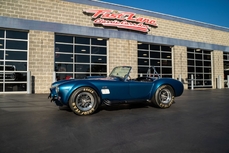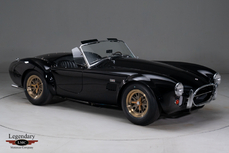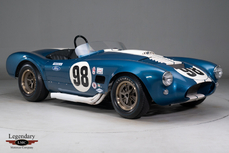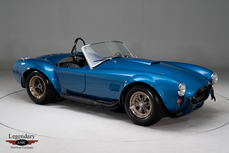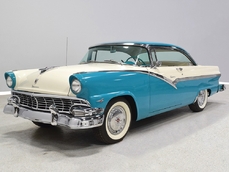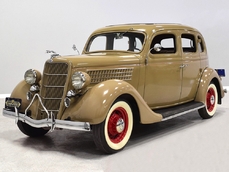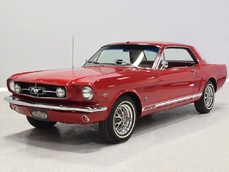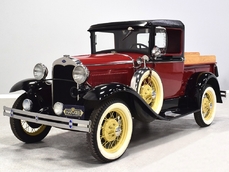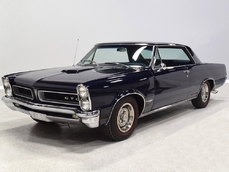Shelby Cobra 427 427 cubic inch V8 1965
Allgemeine Beschreibung :
The Shelby Cobra is the most imitated car of all time. From the dozens (hundreds?) of replica manufacturers to the Dodge Viper, putting a big engine in a small roadster has been a major industry for decades. With real Cobras easily bringing $1 million or more on a routine basis, the replica market has exploded and they’ve become a thing unto themselves, built to suit each individual owner and capable of more performance and speed than any stock original Cobra could imagine.
But if you want the real experience, the feeling that guys had in 1964 when they drove their new Cobras off the dealer lots, there aren’t many choices. A replica Cobra isn’t necessarily an accurate Cobra. Which is where Peter Bayer and Contemporary Classic Motorcars comes in. One of the earliest Cobra replica builders, Contemporary set out to build an affordable alternative to the original, which even in the early 80s was seeing skyrocketing values. Peter Bayer, founder of Contemporary, owned Shelby Cobra CSX3045, a real-deal Cobra, and used that as the blueprint for his replicas. As a result, the Contemporary Cobras are arguably the most accurate replicas ever made, right down to the round tube frames and body molds pulled directly from CSX3045. Today, Contemporary Cobras have become collectors’ items in their own right, representing an uncompromising look at Shelby Cobra building and an authentic experience.
Which brings us to this beautifully built Contemporary Cobra, CCX-33111. This is not a homemade car, but a professionally built Cobra that was assembled and finished with an almost fanatical devotion to originality. It’s powered by a 1965 Ford 427 side-oiler, it has an NOS Toploader 4-speed, and even things like the carburetors and oil pan are NOS Ford parts for a real Cobra. The kit was purchased in 1985 from Russell’s All Custom Engineering in Pomona, California in 1985 by SAAC member Vince Marcy, who used all the Shelby Club’s resources to finish construction. It was completed in 1988 and driven about 1000 miles, but for reasons unknown, it was stored until 1999. Today it shows just 1244 miles, and that’s since it was completed, so it remains in exemplary condition. The fiberglass bodywork is smooth, clean, and devoid of cracks or other issues. The bright Candyapple Red paint with Wimbledon White stripes has a brilliant shine and no evidence that it is now nearly 35 years old. Finish quality is worlds better than you would expect of a replica, with excellent gaps and a huge amount of time invested in getting the panels as smooth as possible. There’s simply not a ripple or wave anywhere on the car and its gentle use and careful storage is reflected in every aspect of the car.
Accurate details abound, including the shape of the car itself. Up front, you’ll note a low-mounted oil cooler, a set of chrome bumperettes, and Lucas-style parking lights. The hood shows proper rivets holding the support brace and scoop in place. Racing-style mirror and wind wings are NOS pieces purchased from a Ford dealer. And, of course, no Cobra is complete without a flip-up gas cap. You will also find correct Cobra badges, a single chrome roll hoop, and unusual rectangular taillights that were unique to the SC cars.
Climbing into the cockpit is to travel in time back to 1965. The buckets are finished in black leather, not vinyl, for a correct look and feel and they really are quite comfortable. The shifter is a Mustang unit that’s flipped backwards for that unique forward-canted look, and the steering wheel, while perhaps a little thicker than 1965, looks quite convincing with its AC horn button (not Cobra) which suggests that details were very important to the builder. Smiths gauges are used in the dash, although they’re not quite exact replicas of the original reverse-rotation units but they’re quite attractive (reproduction reverse-rotation gauges are available today). Toggle switches handle the basics, there’s a pushbutton starter on the left, and nobody even thought about adding a radio or heater. For safety there are 5-point harnesses for both driver and passenger, as well as a fire extinguisher mounted to the forward edge of the transmission tunnel. The carpets, side panels with map pockets, and vinyl dashboard are all in excellent condition with zero signs of use or wear. Even the trunk is neatly finished with a set of matching carpets, along with the fuel pump and remote battery. There is no top, but if you’re using your Cobra correctly, you won’t need one.
The engine is a correct 1965 date-coded 427 cubic inch Ford V8, and it is a correct “side oiler” as used in the original Cobras. It was purchased from Ford Power Parts in Norwalk, California in 1984 and was more recently rebuilt in 2001 by Duffee Motorsports in Phoenix, Arizona. While they worked to keep the external look very much as it would have been in 1965, the internals have been upgraded with a full roller valvetrain, MSD ignition system (concealed in the original distributor) and pump-gas-friendly compression ratio. On top there are a pair of correct vintage 600 CFM Holley 4-barrel carburetors on a mid-rise tunnel ram intake, and they’re beautifully tuned so it starts quickly and idles well. Other correct details include NOS “pentroof” valve covers, a Ford expansion tank, and the round air cleaners on top of the carbs. A Ron Davis aluminum radiator is cooled by a massive electric fan with shroud, so it keeps its cool far better than the original setup. Build photos show twin pusher fans in place when it was completed, but since this car lived in California and Phoenix all its life, keeping it cool was critical. Today it runs ice cold and you should have no fears of running this Cobra at speed or sitting in traffic—it doesn’t care. A modern alternator, water pump, and upgraded plug wires help with reliability without notably compromising the original look.
Contemporary also insisted on an original-style round-tube chassis which few replica builders are using today. The front and rear suspension are Jaguar E-Type, which isn’t quite authentic but makes parts and tuning easy and the infinite adjustment of the Jaguar’s torsion bar front suspension is ideal for setting the car up for performance. Koni shocks all around help keep it buttoned down, yet it rides rather well thanks to Jaguar’s incomparable tuning. It sits low, as a Cobra should, but ride quality isn’t at all harsh. The transmission is an NOS Toploader 4-speed manual that was sourced from another Ford dealer, and you’ll note that even the oil pan is a correct NOS piece that was acquired at great expense from a vendor in Wisconsin (we have the receipt). Accuracy was extremely important here. The Jag’s rear end has 3.54 gears inside, so this Cobra is very street-friendly and the hugely powerful 427 doesn’t ever lack for acceleration in any gear. Jaguar brakes are powerful and easy to service, with the inboard rear discs providing a nice performance advantage. The exposed side pipes have racing mufflers built in, so it sounds like a Cobra but doesn’t make your ears bleed, and they’ve been ceramic coated satin black for a brutal, race-ready look. True knock-off Halibrand wheels are the only logical choice, and even the hubs are safety-wired in place. The tires are recent even though we feel they’re a little over-sized at 235/60/15 in front and 275/50/15 in back, but they don’t seem to present any issues.
Documentation is extensive, from build receipts to photos to Contemporary Classic Motorcars literature and parts lists to period advertising. This is one Cobra replica you can buy with confidence because every nut and bolt in it has a receipt attached and the details are exactly right.
The more we look at this car, the more impressed we are. It’s just gorgeous to look at and even though it takes a practiced eye to spot the small differences between the originals and most replicas, this one nails it. It looks predatory. The authentic parts give it the right feel and performance is electrifying.
http://www.harwoodmotors.com/vehicles/inventory_details.php?id=883
1965 Shelby Cobra 427 427 cubic inch V8 is listed verkauft on ClassicDigest in Macedonia by for $79900.
Fakten der Auto
Karosserietyp : Auto Marke : Shelby Modell : Cobra 427 Ausführung : 427 cubic inch V8 Hubraum : 0.0 Modelljahr : 1965 Lage : Ohio
Verkauft
Angaben Zum Verkäufer
Verkauft
People who viewed this Shelby Cobra 427 also viewed similar Shelby listed at ClassicDigest
Other cars listed for sale by this dealer
über Shelby
Carroll Shelby, eine legendäre Figur in der Automobilwelt, hatte einen bemerkenswerten Weg vom erfolgreichen Rennfahrer zum renommierten Sportwagenhersteller in den Vereinigten Staaten. Seine Geschichte ist voller Erfolge, Innovationen und ikonischer Autos, die einen unauslöschlichen Eindruck in der Branche hinterlassen haben.Frühe Jahre und Rennkarriere:
Carroll Shelby wurde 1923 in Texas geboren. Während des Zweiten Weltkriegs verfolgte er zunächst eine Karriere als Pilot, entdeckte aber nach dem Krieg seine wahre Leidenschaft im Rennsport. Shelby wurde in den 1950er Jahren ein erfolgreicher Rennfahrer und nahm an verschiedenen Veranstaltungen teil, darunter der Formel 1, Langstreckenrennen und den berühmten 24 Stunden von Le Mans.
Shelby Cobras – ikonische Sportwagen:
Carroll Shelbys entscheidender Moment als Hersteller kam mit der Entwicklung des Shelby Cobra, einem legendären amerikanischen Sportwagen. Die Cobra entstand aus der Fusion eines britischen AC-Ace-Chassis und eines Ford-V8-Motors und schuf ein leichtes Hochleistungsauto, das sowohl auf der Rennstrecke als auch auf der Straße dominierte. Zu den wichtigsten Modellen gehören:
Shelby Cobra 260 (1962): Die erste Version mit einem 260 Kubikzoll (4,2 l) V8-Motor.
Shelby Cobra 289 (1963–1965): Spätere Versionen mit einem 289-Kubikzoll-V8-Motor (4,7 l), einschließlich der Cobras mit Wettbewerbsspezifikation, die für ihre Rennfähigkeiten bekannt sind.
Shelby Cobra 427 (1965–1967): Die stärkste Version mit einem 427 Kubikzoll (7,0 l) V8-Motor, bekannt für seine rohe Kraft und Leistung.
Ford-Partnerschaft – Shelby Mustangs:
Shelbys Partnerschaft mit Ford führte zur Entwicklung der legendären Shelby Mustangs. Das bemerkenswerteste Modell ist:
Shelby GT350 (1965–1969): Basierend auf dem Ford Mustang wurde der GT350 von Shelby American modifiziert und zeichnete sich durch verbesserte Leistung, Handling und unverwechselbares Design aus.
Weitere bemerkenswerte Modelle und Erfolge:
Neben den Cobras und Mustangs leistete Shelby noch weitere bedeutende Beiträge:
Shelby Daytona Coupé: Dieses Auto wurde für den Sieg gegen Ferrari im internationalen GT-Rennsport entwickelt und war 1965 das erste amerikanische Auto, das die FIA GT-Weltmeisterschaft gewann.
Shelby Series 1: Ende der 1990er Jahre eingeführt, war dies Shelbys moderne Interpretation eines Hochleistungssportwagens.
Der Ford GT40 spielt in Carroll Shelbys Erzählung eine zentrale Rolle, insbesondere in Bezug auf seine Verbindung zu Ford und seinen bedeutenden Beitrag zum Erfolg des Autos.
Die Entwicklung des Ford GT40:
Fords Herausforderung:
Anfang der 1960er Jahre versuchte Henry Ford II, Ferrari zu erwerben, doch die Verhandlungen scheiterten. Dies bestärkte Ford in seiner Entschlossenheit, Ferrari beim prestigeträchtigen Langstreckenrennen 24 Stunden von Le Mans zu schlagen, das Ferrari mehrere Jahre lang dominiert hatte.
Zusammenarbeit mit Shelby:
Ford wandte sich an Carroll Shelby und schätzte dessen Rennsportkompetenz und Erfolgsbilanz. Shelby wurde damit beauftragt, das GT40-Projekt zu leiten und daraus einen konkurrenzfähigen Rennwagen zu machen, der Ferraris Vormachtstellung herausfordern konnte.
Entwicklung und Triumph:
Unter Shelbys Anleitung wurde der Ford GT40 einer gründlichen Entwicklung unterzogen, um anfängliche Designfehler und Leistungsprobleme zu beheben. Es wurden mehrere Iterationen erstellt:
Frühe Versuche: Die ersten Versionen des GT40 hatten Probleme mit der Zuverlässigkeit und dem Handling, was 1964 zu enttäuschenden Ergebnissen in Le Mans führte.
GT40 Mark II: Shelbys Team hat entscheidende Verbesserungen vorgenommen. Der Mark II, ausgestattet mit einem leistungsstarken V8-Motor, verbesserter Aerodynamik und verfeinerter Technik, wurde äußerst konkurrenzfähig.
Le-Mans-Sieg:
1966 errang der Ford GT40 Mark II einen historischen Sieg bei den 24 Stunden von Le Mans, wobei der von Shelby trainierte Fahrer Ken Miles das Rennen anführte. Dies war der erste Sieg eines amerikanischen Herstellers in Le Mans und brach damit die Dominanz von Ferrari.
Anhaltenden Erfolg:
Der GT40 dominierte weiterhin und gewann in den folgenden drei Jahren (1966–1969) Le Mans, sicherte sich seinen Platz in der Renngeschichte und festigte Fords Ruf als Kraft im internationalen Motorsport.
Shelbys Beitrag zum GT40-Erfolg:
Obwohl Carroll Shelby nicht direkt an der Entwicklung des GT40 beteiligt war, trugen seine Erfahrung im Rennsport und seine Fähigkeit, ein Team aus talentierten Ingenieuren, Mechanikern und Fahrern zusammenzustellen und zu leiten, entscheidend zur Verbesserung der Leistung des Autos bei. Sein Einfluss trug dazu bei, technische Probleme anzugehen, das Fahrverhalten des Autos zu verfeinern und Renntaktiken zu entwickeln, was maßgeblich zum Erfolg des GT40 auf der Rennstrecke beitrug.
Vermächtnis und Auswirkungen:
Die Siege des Ford GT40 in Le Mans unter Shelbys Führung gehören nach wie vor zu den ikonischsten Errungenschaften in der Geschichte des Motorsports. Der Erfolg des Autos festigte Shelbys Ruf als Automobilvisionär und stärkte seine Partnerschaft mit Ford weiter.
Carroll Shelbys Beteiligung am GT40-Projekt stellte seine Fähigkeit unter Beweis, ein schwieriges Projekt in eine Maschine zu verwandeln, die die Meisterschaft gewann, und fügte seiner illustren Karriere in der Automobilwelt ein weiteres bemerkenswertes Kapitel hinzu.



